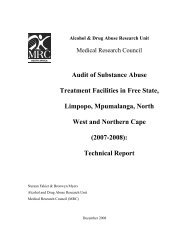Access to substance abuse treatment in the Cape Town metropole ...
Access to substance abuse treatment in the Cape Town metropole ...
Access to substance abuse treatment in the Cape Town metropole ...
Create successful ePaper yourself
Turn your PDF publications into a flip-book with our unique Google optimized e-Paper software.
and R1000 per month than <strong>the</strong>ir female counterparts. For compet<strong>in</strong>g needs,female control subjects had more than double <strong>the</strong> odds of report<strong>in</strong>g additionalf<strong>in</strong>ancial demands (that <strong>to</strong>ok priority over <strong>the</strong> need for <strong>treatment</strong>) than <strong>the</strong>ir malecounterparts. Similarly, females who did not access <strong>treatment</strong> had 1.6 times <strong>the</strong>odds of report<strong>in</strong>g demands <strong>to</strong> care for o<strong>the</strong>rs (that <strong>to</strong>ok priority over <strong>the</strong>ir<strong>treatment</strong> entry) than <strong>the</strong>ir male counterparts (Table 12).Similarly, only a few gender differences were found on cont<strong>in</strong>uousenabl<strong>in</strong>g/restrict<strong>in</strong>g variables significantly associated with access (Table 13).Compared <strong>to</strong> male controls, women reported significantly higher levels of barriersrelated <strong>to</strong> perceived utility and appropriateness of <strong>treatment</strong> services (<strong>in</strong>clud<strong>in</strong>gcultural and gender appropriateness of services). Women also reported moregeographic accessibility barriers (<strong>in</strong>clud<strong>in</strong>g longer travell<strong>in</strong>g times and distances<strong>to</strong> <strong>treatment</strong>) than men. In contrast, male subjects who had not accessed<strong>treatment</strong> reported lower levels of social trust and social cohesion (<strong>in</strong>dica<strong>to</strong>rs ofsocial capital) than <strong>the</strong>ir female counterparts. However, <strong>the</strong>se variables areprobably only weakly associated with gender, given <strong>the</strong> small effects obta<strong>in</strong>ed.4.3.2. Fac<strong>to</strong>rs that differentiate between male and female subjects that didnot access <strong>treatment</strong>To identify fac<strong>to</strong>rs associated with access that differentiate between male andfemale <strong>substance</strong> <strong>abuse</strong>rs who do not access <strong>treatment</strong>, a multivariate logisticregression analyses were performed with gender as <strong>the</strong> dependent variable.This allowed us <strong>to</strong> evaluate <strong>the</strong> <strong>in</strong>dependent contribution of variables associatedwith be<strong>in</strong>g a female <strong>substance</strong> <strong>abuse</strong>r and not access<strong>in</strong>g <strong>treatment</strong> compared <strong>to</strong>be<strong>in</strong>g a male, while controll<strong>in</strong>g for <strong>the</strong> <strong>in</strong>fluence of all o<strong>the</strong>r variables (Table 14).58
















